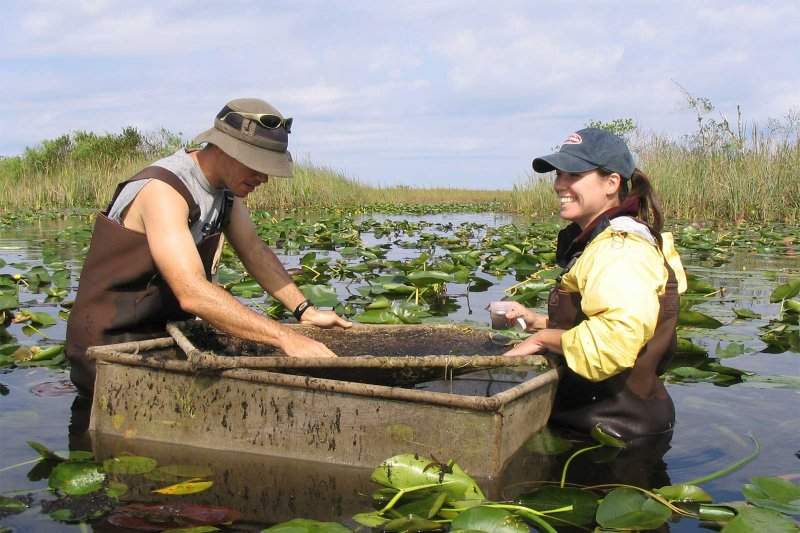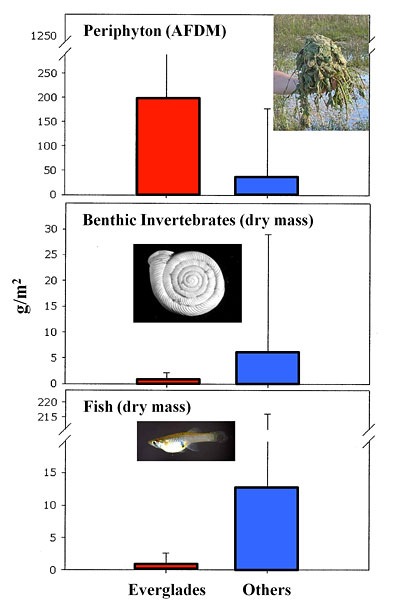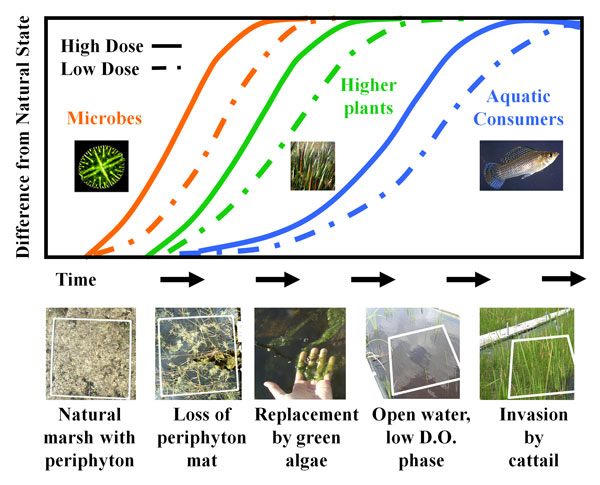FCE scientists revealed how human-induced nutrient enrichment in the Everglades and Caribbean wetlands affect the "productivity paradox" in which an extraordinarily high level of algal growth supports far fewer aquatic animal consumers than expected. Understanding this dynamic is critical to the restoration of the Everglades ecosystem.
- Key Findings
FCE researchers have found that productivity in the Everglades, and other limestone-based Carbbean wetlands, is dominated by extraordinarily productive algal mats, despite extreme nutrient limitation. This phenomenon has been called a "productivity paradox" (Gaiser et al. 2011). This production would be expected to support a large biomass of aquatic primary consumers but does not (Turner et al. 1999). Instead, algal mats are highly inedible and aquatic consumers rely on less energetically efficient detrital pathways (Sargeant et al. 2010). Top predators (i.e., wading birds, large fish, alligators) are supported by the seasonal concentration of these prey animals during the dry season.

Researchers using a throw trap to sample small fish. Long-term research at FCE has been necessary to determine how interannual variation in wet and dry-season hydrology and water quality influence algal mat production, grazer abundance and predator efficiency. Through international collaborative research in other Caribbean wetlands, we have been able to show that this phenomenon is not just distinctive of the Everglades, but of limestone-based Caribbean wetlands in general.
Long-term observational data have been coupled with long-term manipulations of the limiting nutrient, phosphorus, to determine its influence on the productivity paradox and trophic cascades. Our research indicates that anthropogenic nutrient enrichment erases the unusual pyramid of biomass by temporarily increasing algal edibility, thereby increasing production of aquatic consumers. However, phosphorus enrichment ultimately leads to a loss of algal mats, which reduces the structural refuge for aquatic animals, increasing their vulnerability to predation. This shift in algal and consumer biomass and structure is initiated at all phosphorus levels above background levels, and leads to an altered ecosystem state at rates dependent on the nutrient loading rate.
This research is of critical importance to hydrologic restoration of the Everglades and for protection of Caribbean wetlands, as it describes how hydrology controls food web structure directly and through interactions with the loading of the limiting nutrient.
- Results
This graphic compares the biomass structure of the Everglades aquatic food web to other aquatic ecosystems, showing how the large mass of primary production in the Everglades (primarily periphyton) does not translate to a large mass of benthic invertebrates and fish, as would be expected from studies in other aquatic ecosystems. Source: Gaiser, E., J. Trexler and P. Wetzel. 2012. The Florida Everglades. Pages 231-252 In Batzer, D. and A. Baldwin (eds). Wetland habitats of North America: Ecology and Conservation Concerns. Berkeley: University of California Press.

This graphic shows the effects of long-term phosphorus enrichment in Everglades wetlands. FCE scientists have shown that exposure to phosphorus at any level above background initiates a cascade of changes, from a loss of natural periphyton communities, to replacement by more palatable non-mat forming algae, then to an open-water state that eventually leads to the spread of invasive cattails. Credit: Gaiser, E., J. Trexler and P. Wetzel. 2012. The Florida Everglades. Pages 231-252 In Batzer, D. and A. Baldwin (eds). Wetland habitats of North America: Ecology and Conservation Concerns. Berkeley: University of California Press.

- Related Publications
Gaiser, E.E., E.P. Anderson, E. Castañeda-Moya, L. Collado-Vides, J.W. Fourqurean, M.R. Heithaus, R. Jaffe, D. Lagomasino, N. Oehm, R.M. Price, V.H. Rivera-Monroy, R. Roy Chowdhury, and T. Troxler. 2015. New perspectives on an iconic landscape from comparative international long-term ecological research. Ecosphere 6: art181. DOI: 10.1890/ES14-00388.1
Gaiser, E.E., P. V. McCormick, Scot E. Hagerthey and A. D. Gottlieb. 2011. Landscape patterns of periphyton in the Florida Everglades. Environmental Science and Technology 41 (S1): 92-120.
Trexler, J.C., E.E. Gaiser, J. Kominoski, and J.L. Sanchez. 2015. The Role of Periphyton Mats in Consumer Community Structure and Function in Calcareous Wetlands: Lessons from the Everglades, pp. 155-179 in Entry, J., K. Jayachandran, A.D. Gottlieb and A. Ogram (eds.) Microbiology of the Everglades Ecosystem. CRC Press : Boca Raton, Florida.
Turner, A.M., J. C. Trexler, F. Jordan, S.J. Slack, P. Geddes, and W. Loftus. 1999. Targeting ecosystem features for conservation: Standing crops in the Florida Everglades. Conservation Biology 13: 898-911.
Sargeant, B., J. Trexler and E. Gaiser. 2010. Biotic and abiotic determinants of intermediate-consumer trophic diversity in the Florida Everglades. Marine and Freshwater Research. 61: 11-22.
For more information, contact Evelyn Gaiser and Joel Trexler.